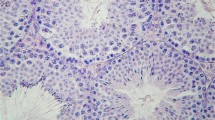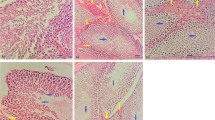Abstract
The hypothesis has been recently presented that lead may exert its negative effect at least partially through the increase of reactive oxygen species (ROS) level in tissues. However, little is known about the influence of lead intoxication on equilibrium between generation and elimination of ROS in the male reproductive system. Sexually mature male Wistar rats were given ad libitum 1% of aqueous solution of lead acetate (PbAc) for 9 months. Significantly higher lead concentrations were found in blood [median 7.03 (Q25–Q75: 2.99–7.65) versus 0.18 (0.12–0.99) μg dl−1, P < 0.01], caput epididymis [median 5.51 (Q25–Q75: 4.31–7.83) versus 0.51 (0.11–0.80) μg g−1 d.m., P < 0.001], cauda epididymis [median 5.88 (Q25–Q75: 4.06–8.37) versus 0.61 (0.2 – 1.08) μg g−1 d.m., P < 0.001] and testis [median 1.81 (Q25–Q75: 0.94–2.31) versus 0.17 (0.03–0.3) μg g−1 d.m., P < 0.01] of lead-intoxicated rats when compared to the control. The concentration of ascorbyl radical, generated in vitro from l-ascorbic acid (present in tissues in vivo) was measured by means of Electron Paramagnetic Resonance (EPR) spectroscopy. The EPR signal of ascorbyl radical in caput epididymis, cauda epididymis, testis and liver of lead acetate-treated animals revealed a significant decrease by 53%, 45%, 40% and 69% versus control tissues, respectively. Plasma l-ascorbic acid content measured by high performance liquid chromatography (HPLC) method and total antioxidant status (TAS) measured by means of spectrophotometry were also significantly lower in the intoxicated versus control animals (28% and 21%, respectively). In the group exposed to lead the concentration of lipid peroxide in homogenates of the reproductive system organs was significantly elevated versus control group. It can be assumed that the lower EPR signal was caused by decreased tissue concentrations of l-ascorbic acid. The latter may have resulted from consumption of ascorbic acid for scavenging of ROS excess in tissues of animals chronically exposed to lead.
Similar content being viewed by others
References
Adonaylo VN, Oteiza PI (1999) Lead intoxication: antioxidant defenses and oxidative damage in rat brain. Toxicology 15:77–85
Aitken RJ (1999) The Amoroso lecture. The human spermatozoon – a cell in crisis? J Reprod Fertil 115:1–7
Alexander BH, Checkoway H, van Netten C et al. (1996) Semen quality of men employed at a lead smelter. Occup Environ Med 53:411–416
Baranowska-Bosiacka I, Hlynczak AJ (2003) The effect of lead ions on the energy metabolism of human erythrocytes in vitro. Comp Biochem Physiol C Toxicol Pharmacol. 134:403–416
Baranowska-Bosiacka I, Wiszniewska B, Marchlewicz M, Hlynczak AJ (2004) Disorders of purine metabolism in human erythrocytes in the state of lead contamination. Pol J Environ Stud 13:467–476
Batra N, Nehru B, Bansal MP (2001) Influence of lead and zinc on rat male reproduction at `biochemical and histopathological levels'. J Appl Toxicol 21:507–512
Batra N, Nehru B, Bansal MP (1998) The effect of zinc supplementation on the effects of lead on the rat testis. Reprod Toxicol 12:507–512
Behari JR (1981) Determination of lead in blood. Int J Environ Anal Chem 10:149–54
Bonde JP, Joffe M, Apostoli P et al. (2002) Sperm count and chromatin structure in men exposed to inorganic lead: lowest adverse effect levels. Occupp Environ Med 59:234–242
Buettner GR, Jurkiewicz BA (1995) Ascorbate radical: avaluable marker of oxidative stress. In: Favier AD, Cadet J (eds), Analysis of Free Radicals in Biological Systems. Birkhaüser Verlag, Basel, Switzerland, pp. 145–164
Cullen MR, Kayne RD, Robins JM (1984) Endocrine and reproductive dysfunction in men associated with occupational inorganic lead intoxication. Arch Environ Health 39:431–440
Fisher HM, Aitken RJ (1997) Comparative analysis of the ability of precursor germ cells and epididymal spermatozoa to generate reactive oxygen metabolites. J Exp Zool 277:390–400
Gandley R, Anderson L, Silbergeld EK (1999) Lead: male-mediated effects on reproduction and development in the rat. Environ Res 80:355–363
Gonet B (1994) Free-radical method for l-ascorbic acid determination in tissues of experimental animals. Curr Top Biophys 18:202–204
Halliwell B, Gutteridge JMC (1999) Free Radicals in Biology and Medicine. Oxford University Press, Oxford, New York
Hsu PC, Hsu CC, Liu MY et al. (1998a) Lead-induced changes in spermatozoa function and metabolism. J Toxicol Environ Health A 55:45–64
Hsu PC, Liu MY, Hsu CC et al. (1998b) Effects of vitamin E and/or C on reactive oxygen species-related lead toxicity in the rat sperm. Toxicology 128:169–179
Hsu PC, Liu MY, Hsu CC, Chen LY, Guo YL (1997) Lead exposure causes generation of reactive oxygen species and functional impairment in rat sperm. Toxicology 122:133–143
Iammarrone E, Balet R, Lower AM, Gillott C, Grudzinskas JG (2003) Male infertility. Best Pract Res Clin Obstet Gynaecol 17:211–229
Irshad M, Chaudhuri PS (2002) Oxidant-antioxidant system: role and significance in human body. Ind J Exp Biol 40:1233–1239
Kruk I (1998) Environmental Toxicology and Chemistry of Oxygen Species. The Handbook of Environmental Chemistry Vol 2. Springer, Berlin
Marchlewicz M, Michalska T, Wiszniewska B (2004) Detection of lead-induced oxidative stress in the rat epididymis by chemiluminescence. Chemosphere 57:1553–1562
Marchlewicz M, Protasowicki M, Różewicka L, Piasecka M, Laszczyńska M (1993) Effect of long-term exposure to lead on testis and epididymis in rats. Folia Histochem Cytobiol 31:55–62
Muto N, Ohta T, Suzuki T, Itoh N, Tanaka K (1997) Evidence for the involvement of a muscarinic receptor in ascorbic acid secretion in the rat stomach. Biochem Pharmacol 53:553–559
Patra RC, Swarup D, Dwivedi SK (2001) Antioxidant effects of alpha tocopherol, ascorbic acid and l-methionine on lead induced oxidative stress to the liver, kidney and brain in rats. Toxicology 162:81–88
Riley JCM, Behrman HR (1991) Oxygen radicals and reactive oxygen species in reproduction. Proc Soc Exp Biol Med 198:781–791
Roginsky VA, Stegmann HB (1994) Ascorbyl radical as natural indicator of oxidative stress: quantitative regularities. Free Rad Biol Med 17:93–103
Satoh K (1978) Serum lipid peroxide in cerebrovascular disorders determined by a new colorimetric method. Clin Chim Acta 90:37–43
Sevanian A, Davies KJ, Hochstein P (1991). Serum urate as an antioxidant for ascorbic acid. Am J Clin Nutr 54:1129–1134
Thoreux-Manlay A, Velez de la Calle JF, Olivier MF, Soufir JC, Masse R, Pinon-Lataillade G (1995). Impairment of testicular endocrine function after lead intoxication in the adult rat. Toxicology 100:101–109
Upasani CD, Khera A, Balaraman R (2001) Effect of lead with E, C, or Spirulina on malondialdehyde, conjugated dienes and hydroperoxides in rats. Ind J Exp Biol 39:70–74
Vaglenov A, Creus A, Laltchev S, Petkova V, Pavlova S, Marcos R. (2001) Occupational exposure to lead and induction of genetic damage. Environ Health Perspect 109:295–298
Valverde M, Trejo C, Rojas E (2001) Is the capacity of lead acetate and cadmium chloride to induce genotoxic damage due to direct DNA metal interaction ? Mutagenesis 16:265–270
Yang JL, Wang LCh, Chang ChY, Liu TY (1999) Singlet oxygen is the major species participating in the induction of DNA strand breakage and 8-hydroxydeoxyguanosine adduct by lead acetate. Environ Mol Mutagen 33:194–201
Ye X, Fu H, Zhu J et al. (1999) A study on oxidative stress in lead-exposed workers. J Toxicol Environ Health A 56:161–172
Acknowledgements
The research was supported by the State Committee for Scientific Research as a Solicited Project PBZ-KBN-084/P06/2002 from year 2003 to 2005.
Author information
Authors and Affiliations
Corresponding author
Rights and permissions
About this article
Cite this article
Marchlewicz, M., Wiszniewska, B., Gonet, B. et al. Increased Lipid Peroxidation and Ascorbic Acid Utilization in Testis and Epididymis of Rats Chronically Exposed to Lead. Biometals 20, 13–19 (2007). https://doi.org/10.1007/s10534-006-9009-z
Received:
Accepted:
Published:
Issue Date:
DOI: https://doi.org/10.1007/s10534-006-9009-z




